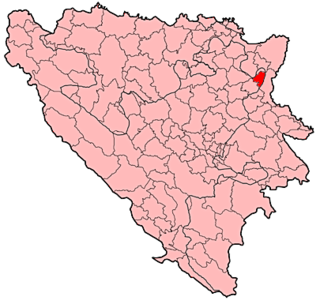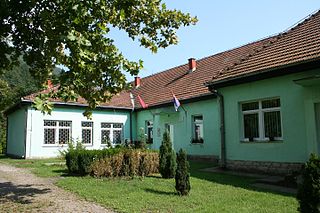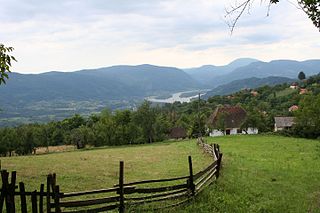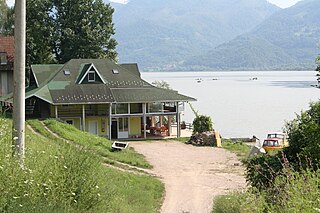Crni Vrh means "black peak" in Bosnian-Croatian-Serbian. It may refer to:

Zvornik is a city in Bosnia and Herzegovina. It is located in entity of Republika Srpska, on the left bank of the Drina river. As of 2013, it has a population of 58,856 inhabitants.

Mali Zvornik is a town and municipality located in the Mačva District of western Serbia. In 2011, the population of the town is 4,132, while the population of the municipality is 11,987. It lays opposite of the Drina river from the town of Zvornik, in Bosnia and Herzegovina. Also, a border crossing between Serbia and Bosnia and Herzegovina is located in the town.

Sapna is a town and municipality located in Tuzla Canton of the Federation of Bosnia and Herzegovina, an entity of Bosnia and Herzegovina.
The Yellow Wasps were a Serbian paramilitary group which was active in the Bosnian War. It was headed by Vojin Vučković and Dušan Repić. The group was active in the Zvornik region. Vojin and his brother Duško were convicted in 1996 for killing of 17 civilians in Čelopek, a suburb of the town of Zvornik, during the ethnic cleansing of the Bosniak population of the Drina valley in 1992. Four other members of the group have also been charged with war crimes.

The Drina is a 346 km (215 mi) long Balkans river, which forms a large portion of the border between Bosnia and Herzegovina and Serbia. It is the longest tributary of the Sava River and the longest karst river in the Dinaric Alps which belongs to the Danube river watershed. Its name is derived from the Roman name of the river which in turn is derived from Greek.

Amajić is a village in west-central Serbia. It is situated in the municipality of Mali Zvornik in the Mačva District of Central Serbia. The village is located on the banks of Zvornik Lake, a reservoir of the Drina River, on the international border between Serbia and Bosnia and Herzegovina. The population was 156 at the 2011 census.

Brasina is a village in Serbia. It is situated in the Mali Zvornik municipality, in the Mačva District of Central Serbia. The village has a Serb ethnic majority with a population of 1,663.

Budišić is a village in Serbia. It is situated in the Mali Zvornik municipality, in the Mačva District of Central Serbia. The village has a Serb ethnic majority and its population numbers 249 people, of which 247 are Serbs.

Velika Reka is a village in Serbia. It is situated in the Mali Zvornik municipality, in the Mačva District of Central Serbia. The village has a Serb ethnic majority with a population of 476.

Voljevci is a village in Serbia. It is situated in the Mali Zvornik municipality, in the Mačva District of Central Serbia. The village has a Serb ethnic majority and its population numbers 719 people, of which 702 are Serbs.

Radalj is a village in Serbia. It is situated in the Mali Zvornik municipality, in the Mačva District of Central Serbia. The population of the village is 2,497 and it has an overall Serb ethnic majority.

Culine is a village in Serbia. It is situated in the Mali Zvornik municipality, in the Mačva District of Central Serbia. The village has a Serb ethnic majority and its population was 389 in 2002.

Donja Trešnjica is a village in Serbia. It is situated in the Mali Zvornik municipality, in the Mačva District of Central Serbia. The population of the village is 688 with 682 people comprising the Serb ethnic majority.

Čitluk is a village in Serbia. It is situated in the Mali Zvornik municipality, in the Mačva District of Central Serbia. The population of the village is 238, all of which are Serbs.
Đulići is a village located in the Zvornik Municipality, Bosnia and Herzegovina.

The Zvornik massacre refers to acts of mass murder and violence committed against Bosniaks and other non-Serb civilians in Zvornik by Serb paramilitary groups at the beginning of the Bosnian War in 1992. It was part of a wider campaign of ethnic cleansing in the Bosnian War: by one estimate, 40,000 Bosniaks were expelled from the Zvornik district.
The Bijeli Potok massacre refers to the mass killing of 684 Bosniak civilians by Serbs on 1 June 1992 in the settlement Bijeli Potok within the village Đulići, located in the municipality of Zvornik, Bosnia and Herzegovina. About 684 Bosniak men and boys, from the multiple villages around Zvornik, were separated from their families by Serb forces, and slaughtered within a week at Bijeli Potok and their bodies hidden in mass graves throughout the Drina Valley.

The Eparchy of Zvornik and Tuzla is an eparchy of the Serbian Orthodox Church with its seat in Bijeljina, Bosnia and Herzegovina. It has jurisdiction over the north-eastern regions of Bosnia and Herzegovina. Since 2017, Bishop of Zvornik and Tuzla is Fotije Sladojević.
This page is based on this
Wikipedia article Text is available under the
CC BY-SA 4.0 license; additional terms may apply.
Images, videos and audio are available under their respective licenses.















